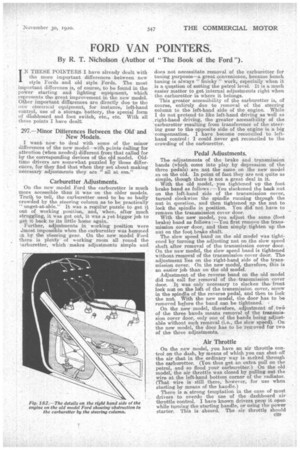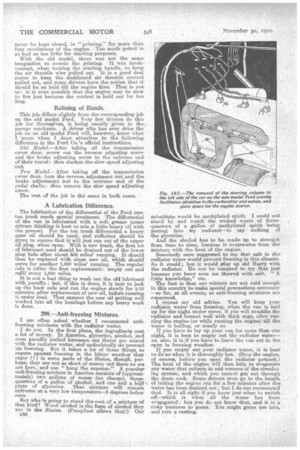FORD VAN POINTERS:
Page 23

Page 24

If you've noticed an error in this article please click here to report it so we can fix it.
By R. T. Nicholson (Author of "The Book of the Ford ").
1 ' .N THESE POINTERS I have already dealt with the more important. differences between new style Fords and old style Fords. The most important difference is, of course, to be found in the power starting and lighting equipment, which represents the great improvement in the new model. Other important differences are .directly due to the new electrical equipment, for instance, left-hand control, use of a storage battery, the special form of dashboard and foot switch, etc., etc. With all these points I have. dealt.
297.--Minor Differences Between the Old' and • New Models.
I want. now to deal with some of the minor differences of the new model—with prints ceiling for attention (when needed) different from that called' for by the corresponding devices of the old model. Oldtime drivers are somewhat puzzled by those differences, for they find that when they set about making necessary adjustmentS they are "all at seal."
Carburetter Adjustments.
• On the new model Ford the carburetter is much more accessible than it was on the older models. Truth to tell, tho carburetter used to be so badly crowded by the steering column as, to be practically " unget-at-able." It was a. regular puzzle to get it out of working position, and, when, after much struggling, it was got out, it was a yet bigger job to got R, back to its little home again. . Further, adjustments in working position were ilmost impossible when the carburetter was hemmed in by the steering gear. On the new model Ford there is plenty of working ' room all round the larburetter, which makes adjustments simple and does not necessitate, removal of the carburetter for tuning purposes—a great convenience, because bench tuning is always " finicky " work, especially when. it is a question of setting the petrol level. It is a much easier matter to get internal adjustments right when the carburettor is where it belongs.
This greater accessibility of the carburetter is, of course, entirely due to removal of the steering column to the left-hand side of the engine. While I do not pretend to like left-hand driving as well as .right-hand driving, the greater accessibility of the 'carburetter resulting from transference of the steering gear to the opposite side of the engine is a big compensation. I have become reconciled to lefthand control: I could never get reconciled to the crowding of the carburetter.
Pedal Adjustments.
The adjustments of the brake and transmission bands (which come into play by depression of the three pedals) are not the same on the new model as on the old. In point of fact they are not quite as simple, though there is not a great deal in it.
With the old model, you tightened up the foot brake band as follows :—You Blackened the back nut on the left-hand gide of the transmission cover, turned clockwise the spindle running through the nut in question, and then tightened up the nut to lock the spindle in position. You did net have to remove the transmission cover door.
With the, new model, you adjust the same (foot brake) band as follows :—You first remove the transmission coyer door, and then simply tighten up the nut on the foot brake shaft. The slow speed band on the old model was tightened by turning the adjusting nut on the slow speed shaft after removal of the transmission cover door. On the new model, the slow speed band is tightened without removal of the transmission cover door. The adjustment lies on the right-hand Bide of the transmission cover. On the new mode!, therefore, this is an easier job than on the old model. Adjustment of the reverse band on the old model did not call for removal of the transmission cover door. It was only necessary to slacken thefront lock nut on the left of the transmission cover, Screw in the spindle of the reverse pedal, and then to rock the nut. With the new model, -the door has to be removed before the band can be tightened.
On the new model, therefore, adjustment of ,twi; of the three bands means removal of the transmission cover door, only one of the baras being adjustable without such removal (i.e., the Blow speed). On the new model, the door has to be removed for two of the three adjustments.
Air Throttle
On the new model, you have an air throttle control on the dash, by means of which you can shut off the air that in. the ordinary way is sneked through the carburetter. (You thus get an extra pull on the petrol, and so flood your carburetter.) On the old model, the air throttle was closed by pulling out the wire at the left-hand bottom corner of the radiator. (That wire is still there, however, for use when starting by means of the handle.) There is a strong temptation in the case of most drivers to overdo the use of the dashboard air throttle control. I have known drivers prop it open while turning the starting handle, or using the power starter. This is absurd. The air throttle Should never be kept closed, in " priming," for more than four revolutions of the engine. Too much petrol is as bad as too little for starting purposes.
With the old model, there was not the same temptation to overdo the priming. It was inconvenient, when turning the starting handle, to keep the air throttle wire pulled out. It is a good. deal easier to keep the dashboard air throttle. control pulled out, and some drivers have the notion that it should be so held till the engine fires. That is not : it is even possible that the engine may be slow to fire just because the control, is held out for too long.
Relining of Bands.
This job differs slightly from. the corresponding job on the old model Ford. Very few drivers do this job for •theinselves, it being usually given to the. garage mechanic. A driver who has ever dene the job an an old model Ford will,. however, know what I mean when I draw attention to the following difference in the Ford Co.'s official instructions.
Old Model.—After taking off the transmission cover door, screw out the reverse adjusting screw and the brake adjusting screw to the extreme end of their travel: then slacken the slow speed adjusting 'nut.
New Model.—After taking off the transmission cover door, turn the reverse adjustment nut and thebrake adjustment nut to the extreme end of the pedal shafts : then remove the slow speed adjusting screw.
The rest ot the job is the' same in both cases.
A Lubrication Difference.
The lubrication of the differential of the Ford oneton truck needs special treatment. The differential of the van is lubricated with a soft grease (some drivers thinking it best to mix a little heavy oil with the grease). For the ton truck differential a heavy gear eil should be used, and siifficient should be given to ensure that it will just ran. out of the upper oil plug, when open. With a new truck, the first lot of lubricant used should be drained out of the lower plug hole. after about NCI miles' running. It should then be replaced with clean new ail, which should serve for another 1,000 miles' running. The regular rule is (after the first replacement): empty out and refill every 1,000 miles.
It is not a bad thing to wash out the old lubricant with paraffin ; but, if this is done, it is best to jack up the back axle and run the engine slowly for 5-10 minutes, after replacement of new oil, before running it under load. That ensures the new oil getting well worked into all the bearings before any heavy work is done.
398.—Anti-freezing Mixtures.
I am often ,asked whether I recommend antifreezing mixtures with the radiator water.
I do not. In the first plate the ingredients cost a rot of money. In America, glycerine, alcohol, and even paraffin (called kerosene out there) are mixed with the radiator water, and undoubtedly do prevent its freezing. But it takes a lot of these things to ensure against freezing in the bitter weather they enjoy (? ) in some parts of the States, though, perhaps, they are not as short of money out there as we are here, and can "hang the expense." A popular anti-freezing mixture in America consists of (approximately) two gallons of water (no charge), threequarters of a gallon of alcohol, and one and a half pints of glycerine. That mixture will remain unfrozen at a very low temperature-8 degrees below zero.
But who is going to stand the cost of a mixture of that kind? Wood alcohol is the form of alcohol they use in the States. (Pussyfoot allows that!) Our
ea) substitute, would be methylated spirit. I could not stand by and watch the wicked waste of threequarters of a gallon of methylated spirit being poured into my radiator—to say nothing of the glycerine. And the alcohol has to be made up to strength from finiet to time, because it evaporates from the, mixture with the heat of the engine..
Somebody once suggested to me that salt in the radiator water would prevent freezing in this climate. So it would; but it would play up old Harry with • the radiator. Do not: be tempted to try that just because you have seen ice thawed with salt. A little knowledge," etc. The fact is that our winters are not cold enough in this country to make special precautions necessary —so far, at all events, as anti-freezing mixtures are concerned.
I repeat my old advice. You will keep your radiator water from freezing, When the van is laid up for the night under cover, if you will swaddle the radiator and bonnet well will thick rugs, after running the engine (or while running the engine) till the water is boiling, or nearly so.
If you have to lay up your van for mere than one night, it is best to empty out the radiator water— as, also, it is if you have to leave the van out in the open in freezing weather.
If you empty out your radiator water, it is best to do soi when it is thoroughly hot. (Stop the engine, of course, before you open the radiator petcock.) The heat of the engine will then help to evaporate any water that collects in odd corners of the circulating system, and which you cannot get out through the drain cook. Some drivers drven go to the length of letting the engine run for a few minutes after the water has been drained out; but I do not recommend that. It is all right if you how just when to switch off—which is when all the water has been evaperated ; but you do not know that, and it is a risky business to guess. You might guess too late, and ruin a casting.




























